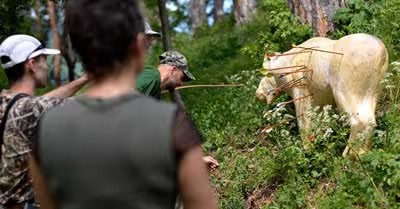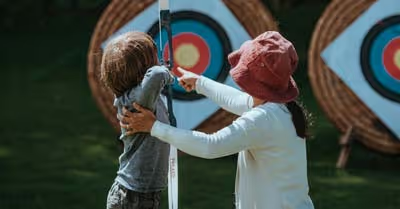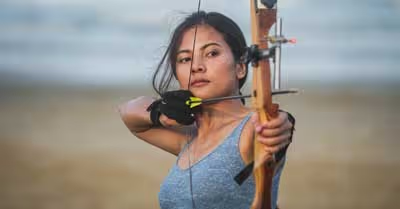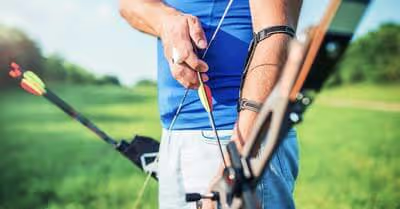Table of Contents
Target archery, field archery, and other forms of the sport
Target archery is what most people imagine when they think of the sport. Target archery can be either indoors or outdoors and involves aiming for the center of a target. Target archery is for all levels of competitiveness - someone who occasionally plays for fun all the way up to a world champion.
If you are just getting started with archery, target archery is the easiest. There is an enormous range of skill levels, all the way up to Olympic medalists, but you can get reasonably good at it fast if you try target archery.
If you don't want to stick with standard target archery for long after developing a basic skill level, there are other choices. You could try field archery instead. Field archery is always outdoors and involves shooting at targets at different elevation levels.
In field archery, you have to learn to shoot in non-ideal conditions. You will have to hit targets in the wind or in little light. You will also not know exactly how far away the targets are in field archery, so you will have to learn to judge distances yourself.
You do not have to be an expert to do field archery or any other alternative form of archery. I recommend starting with target archery, but alternative forms of archery are suitable for lower skill levels.
Other options are combat archery, where two teams shoot reasonably safe arrows at each other, and 3D archery, where you shoot at three-dimensional targets resembling animals. People also compete with crossbows. There is also bow-hunting and bow-fishing for those skilled with a bow and arrow to try.
Is archery hard to learn?
Usually, someone who has never tried a bow before is bad at archery. Don't let the first day discourage you - you can get good at it, and it won't take that long.
At the start, practice shooting close to the target. Shoot from as little as ten feet away. Learn to aim the bow from a very short distance first and then learn to shoot at longer distances.
How strong do you have to be to succeed at archery?
While medieval military archers had to be muscular, this is less true for most modern competitive archery. An archer needs to be fairly but not very strong.
More strength is not always an advantage - a bow has a maximum draw weight. Because of this maximum, more strength after a certain point is no further advantage.
Even if you are not very strong at the start, you can develop your upper body muscles by practicing archery. Practicing with a bow can work as well as lifting weights for building muscle. You have to work your chest and your back as well as your arms to pull a bow.
Archery has other benefits besides strength training. You can improve your balance (you need to keep your body very still when pulling the bow, which requires excellent balance) and improve your concentration.
Can you practice archery if you are left-handed?
Yes, you can find left-handed bows if you look around for them. Right-handed bows will be too awkward to use.
What equipment do you need to start?
You should have a bow and have some basic safety equipment. A bow, an armguard, and a chestguard should be enough to start. Some people start with a relatively expensive bow; others choose something cheaper and then upgrade later on.
Your first bow should be a recurve bow rather than a compound bow. A recurve bow is both easy for beginners to use and can be used in typical amateur competitions.
A compound bow is more complicated as it uses pulleys. Training lessons with compound bows are harder to find, and so are competitions. Compound bows are better for hunting.
Try several different bows and find a great bow, as you won't do nearly as well at or enjoy the sport without the right bow for you. There is a huge variety of different bows to try, so the choices can seem overwhelming.
Choose the right draw length and draw weight
The two most important things when choosing a bow are draw length and draw weight. Draw length is how far you can pull the arrow back before firing.
The best draw length for you is roughly your height divided by 2.5 inches - someone six feet three would use a bow with a draw length of 30 inches. You might prefer a bow that has slightly more or less draw length, but it will usually not be very far from what your height would suggest.
Draw weight also matters. Draw weight is how much force you have to apply to the string to pull it back far enough. If you get stronger through archery practice, you might switch to a bow with higher draw weight.
Can you rent archery equipment?
Yes, that is a good idea in the short run. If you have little or no experience with a bow and aren't sure whether you want to get into archery, rent the equipment at the range first.
Renting equipment at the archery range is an opportunity to try a few different bows. Once you are sure, you should buy the equipment as renting gets more expensive than buying quickly. You can also practice whenever you want if you have your own bow and arrows.
Is archery expensive?
About $700 is more than enough to purchase quality archery equipment. If you want quality equipment for less, you can find it, but it may be harder to find. Less than $500 is also realistic.
The bow is by far the most expensive part of your equipment. Arrows and safety equipment may cost you only about $75 in total, with the bow being the rest of the expense. Your equipment may be good enough to last for many years at these prices.
How important is archery safety equipment?
The point of a chest guard in archery is that it prevents your clothing from getting tangled up in the bowstring. If your clothes get caught in your string, the arrow can fly off in a dangerous direction.
A chestguard is worn over your clothes and cannot get caught in the bowstring. An armguard has the same purpose. You might also use a piece of leather called a bow release to make it easier to pull the string back without hurting your hand a little.
How do people get better at archery?
One of the best ways to get better at archery over time is to start shooting the target at close range and then gradually increase the distance. Try to maintain the same level of accuracy from farther away.
Relax when you shoot. Don't put too much conscious effort into it. If you can be calm when you let the arrow go, you will shoot better.
When you aim, breathe in deeply. That will help you focus and calmly fire the arrow.
Learn how to stand in the correct position when you shoot. Don't experiment with your own very unusual technique - after you shoot arrows in the correct stance enough times, it will start to feel right. Look down the spine of the arrow when you shoot.
Stand completely still when you release the arrow. This is one of the best ways to move beyond a beginner level of skill.
If you move when you shoot, you will nudge the arrow and be less accurate. Even a small amount of movement can hurt your aim more than a little.
Don't wait too long to start entering competitions. It isn't a big deal to place poorly in your first competition. When you get reasonably good with a bow, try entering a small local competition to see how far you have to go before you are a very good amateur competitive archer.
Recent Articles
















